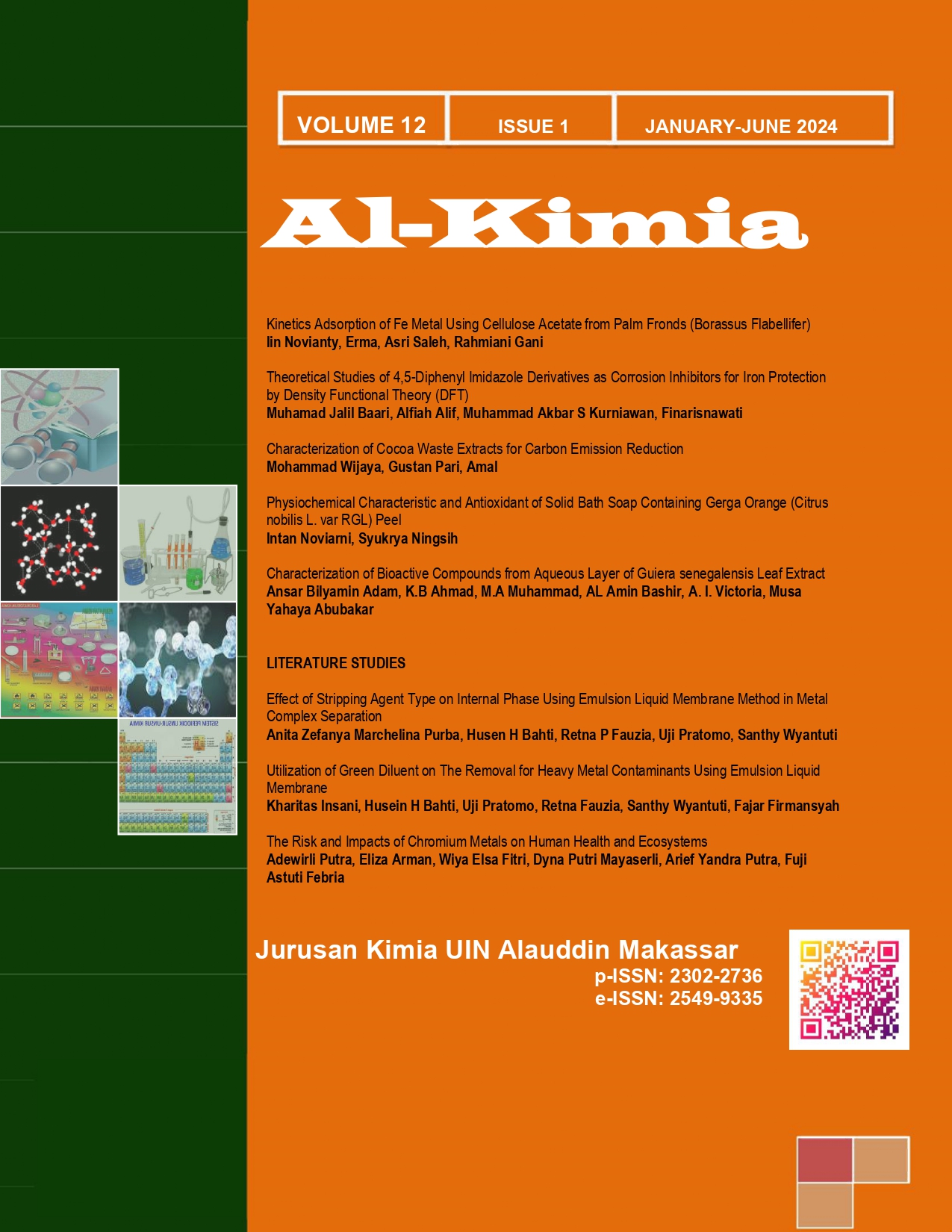Physiochemical Characteristic and Antioxidant of Solid Bath Soap Containing Gerga Orange (Citrus nobilis L. var RGL) Peel
The Formula and Anti-oxidant Properties of The Gerga Orange Peel (Citrus nobilis L. var RGL) Extract-containing Organic Soap
Abstract
The study primarily focused on analyzing the prospective utilization of waste biomass, particularly those possessing antioxidant properties, for soap formulation. Antioxidants serve as radical scavengers, protecting against oxidative damage in both soap and human skin. This research aims to assess solid bath soap's efficacy and antioxidant potential when combined with Gerga orange peel (Citrus nobilis L. var RGL) extract. The quality of the bath soap was evaluated based on the Indonesian National Standard (INS) 3532:2021. The antioxidant activity of the soap was determined using the DPPH (2,2-diphenyl-1-picrylhydrazyl) radical scavenging technique. The solid bath soap formulations underwent rigorous quality testing, and the findings indicated that they exceeded the standards set by INS 3532:2021 for solid bath soap quality. These formulations demonstrated superior performance in various parameters, including pH levels, moisture content, free fatty acids, free alkali, solubility in alcohol, and foaming capabilities. The antioxidant activity of each soap formulation was quantified by its IC50 value. The results showed that the level of antioxidant activity in the solid bath soap increased proportionally with the quantity of Gerga orange peel extract used. Overall, the findings suggest a favorable potential for utilizing Gerga orange peel extract as a cost-effective and feasible natural antioxidant component in soap production.
Downloads
References
Anbarasu, K., Dhanappriya, R., Raman, D., Rajeswary, H., Sivakumar, P., 2012. In vivo study of antidiarrhoeal activity of dairy waste whey. Asian J. Pharm. Clin. Res. 5, 118–121.
Aras, N.R.M., Nur, R.A., Isma, Yusriadi. 2023. Antiseptic Liquid Soap from Corn Oil (Zea mays L.) and Aloe Vera Extract with the variation of SLS (Sodium Lauryl Sulfate). Indo. Chim. Acta, 16(1), 23-31. https://doi.org/10.20956/ica.v1.6i1.26653
Ashfaq, M., & Ali, M. 2017. Impact of Celebrity Endorsement on Consumer Buying Behavior in FMCG Sector of Pakistan. Oman Chapter of Arabian Journal of Business and Management Review, 34(5627), 1–12.
Atolani, O., Adamu N., Zubair M.F., Fabiya, O.A, Oyagoke, R.A., Adeyemi, O.S., Areh, W.T., Tarigah, D. E., Kambizi, L., Oyegoke, G.A. 2020. Chemical Characterization, Antioxidant, Cytotoxicity, Anti-Toxoplasma Gondii And Antimicrobial Potentials of The Citurs Sinensis Seed Oil for Suistainable Cosmeceutical Production. Heliyon. 6, 2405-8440. https://doi.org/10.1016/j.heliyon.2020.e03399
Atolani, O., Olabiyi, E.T., Issa, A.A., Azeez, H.T., Onoja, E.G., Ibrahim, S.O., Zubair, M.F., Oguntoye, O.S., Olatunji, G.A., 2016. Green synthesis and characterisation of natural antiseptic soaps from the oils of underutilised tropical seed. Sustain. Chem. Pharm. 4, 32–39. http://dx.doi.org/10. 1016/j.scp.2016.07.006.
Atolani, O., Olatunji, G.A., 2016. Chemical composition, antioxidant and cytotoxicity potential of Daniellia oliveri (Rolfe) Hutch. & Dalz. Turkish. J. Pharmacol. Sci. 13 (1), 84–94.
BSN. (2021). Sabun Mandi Padat, SNI 3532:2021.
Fauziah, D.W, Mahrunisa, Kipli, D.F. 2019. Skrining Fitokimia dan Penetapan Kandungan Senyawa Flavonoid Ekstrak Etanol Kulit Buah Jeruk Gerga dengan Metode Spektrofotometri UV-VIS. Jurnal Ilmiah Pharmacy, 6(2), 301–311.
Handayani, S., Arty, I.S., Budimarwanti C., Theresih, K., Yulianti, E., Khairuddean, M. 2021. Preparation and Antimicrobial Activity Analysis of Organic Soap Bar Containing Gnetum gnemon Peel Extract. Molekul,16(3), 226-234. https://doi.org/10.20884/1.jm.2021.16.3.800
N.A. Indrastuti, S.Aminah. 2019. Potensi Limbah Kulit Jeruk Lokal Sebagai Pangan Fungsional, Prosiding Seminar Nasional Teknologi Pangan,13,2,122-129
Noviarni, I., Batubara, I., & Putri, S. P. 2020. Antiglycation and Antioxidant Activity from Methanol Extract and Fraction of Xylocarpus granatum Stem. Jurnal Kimia Sains Dan Aplikasi, 23(1), 21–27. https://doi.org/10.14710/jksa.23.1.21-27
R.E. Abdelazem, H.T. Hefnawy, G.A. El-Shorgaby. 2021. Chemical Composition and Phytochemical Screening of Citrus sinensis (Orange) Peels. Biotechnology Research, 48(3),793-803.
Rambabu, K., Edthill, A., Nirmala, G.S., Hasan, S.W., Yousef, A.F., Show, P.L., Banat, F. 2020. Date-Fruit Syrup Waste Extract as a Natural Additive for Soap Production with Enhanced Antioxidant and Antibacterial Activity. Environmental Technology & Innovation, 20(5), 2352-1864. https://doi.org/10.1016/j.eti.2020.101153
Salanti, F.J., Momuat, L.i., Harry, S.J.K. 2022. Quality Testing and Antioxidant Activity of ¬¬Soap Contains Algae Extract Eucheuma spionosum. Jurnal Ilmiah Sains, 22(2), 172-179. https://doi.org/10.35799/jis.ev22i2.43904
Sivakumar, Padmanaban, Sivakumar, Pandian, Anbarasu, K., Pandian, K., Renganathan, S., 2013. Synthesis of silver nanorods from food industrial waste and their application in improving the keeping quality of milk. Ind. Eng. Chem. Res. 52, 17676–17681.
Tunmuni, D., Astiti, N. P. A., & Sudirga, S. K. 2021. Aktivitas Antioksidan Ekstrak Kulit Jeruk Keprok (Citrus Reticulata Blanco) So’e Sebagai Teh Tradisional. Metamorfosa: Journal Of Biological Sciences, 8(2), 274. https://doi.Org/10.24843/Metamorfosa.2021.V08.I02.P11.
Authors who publish with this journal agree to the following terms:
1) Authors retain copyright and grant the journal right of first publication with the work simultaneously licensed under a Creative Commons Attribution License that allows others to share the work with an acknowledgement of the work's authorship and initial publication in this journal.
2) Authors are able to enter into separate, additional contractual arrangements for the non-exclusive distribution of the journal's published version of the work (e.g., post it to an institutional repository or publish it in a book), with an acknowledgement of its initial publication in this journal.
3)Authors are permitted and encouraged to post their work online (e.g., in institutional repositories or on their website) prior to and during the submission process, as it can lead to productive exchanges, as well as earlier and greater citation of published work (See The Effect of Open Access).


